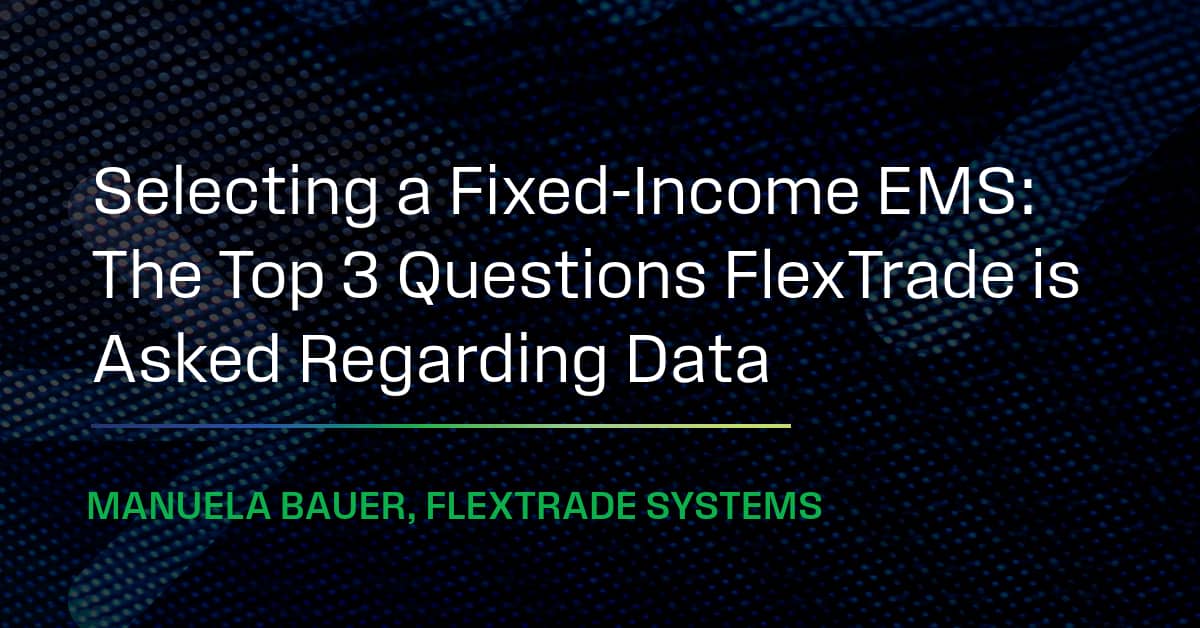Selecting a Fixed Income EMS: The Top 3 Questions FlexTrade is Asked Regarding Data
July 31, 2024 | By: Iain Smith

In the past year, there has been a significant shift in the conversation within the fixed-income trading space. Rather than debating the need for a fixed-income EMS, the focus has moved towards identifying the right EMS and its specific functionalities that can help optimize best execution efforts.
One major factor driving this shift has been the need to manage the expanding volume of data available in bond trading. This includes innovative pre-trade data offerings like Propellant Digital and Solve, as well as more traditional data points such as axes, IOIs, reference and dealer prices, and liquidity scores. All this data can be aggregated using a fixed-income EMS.
Through our conversations with clients, prospects, and industry consultants, we’ve identified the top 3 most common questions that firms ask regarding data when considering deploying a fixed-income EMS like FlexFI.
1. What percentage of pre-trade data and analytics are delivered with FlexTrade’s Fixed Income EMS “Out of the Box”? And how much is configured bespoke for each client?
Whether it’s an existing FlexTrade client looking to expand their use of FlexTRADER EMS or a new client implementing FlexFI, we offer a high percentage of pre-trade data and analytics out of the box.
For all new clients, as part of the implementation process, FlexTrade’s Onboarding Team uploads previous historical trading data in bulk to their new, unique instance of FlexFI. This means data is available and ready to use on day one of production and visualized using “out-of-the-box” standard templates.
Using bespoke calculations, clients using FlexFI can further refine these standard pre-trade analytics according to their requirements. For example, a trader working with the data could create a calculation assigning different weights to various previous hit ratios and current axes available in the system, combining it with real-time market intelligence to guide dealer selection, either on a manual RFQ or to feed into automation.
2. What data sources can be ingested into FlexFI?
Fixed income has seen an explosion of data – all of which can be ingested into the FlexFI EMS order blotter.
Alongside their own historical trading data, FlexFI users can enrich their data with third-party sources, such as market and pricing data, based on their unique workflows. For instance, AXES, IOIs, Dealer Runs, and FIRM Liquidity can all be streamed directly into FlexFI and captured using the solution’s liquidity aggregator tool, “BondWidget.”
Further, pricing data from various sources such as Bloomberg, ICE CEP, and MarketAxess CP can also be captured via FlexFI’s BondWidget and made available in different parts of the FlexTrade GUI, such as blotters, and incorporated into venue-agnostic trading tickets.
FlexFI’s BondWidget is so tightly integrated within the client trading blotter that it has a unique ability to incorporate important information in the OMS or EMS, such as broker restrictions or directions.
This trading context awareness differentiates FlexTrade’s solution from other standalone data aggregation solutions. All pre-trade data can be viewed from the order blotter, eliminating the need to investigate broker axes, Bloomberg, trading venues, or pricing platforms.
Further, a new development, FlexFI’s Data Lake, seamlessly connects to the FlexFI BondWidget and can ingest a fully aggregated, clean, normalized, and de-duplicated fixed-income trading data set. From the Data Lake, it is available for deep analysis by quant teams or can be leveraged for charting, analytics, and on-the-fly reporting.
Data points ranging from historical quotes, pricing, ISINs, and protocols are available and can be supplemented with the client’s own trading activity in real-time, such as price requests, all executions, and competing quotes.
Having this data in one place as a single source of truth enables in-house analysis to determine anything from broker and axe quality rankings and in-time TCA to the identification of bonds on the trading blotter that are similarly structured to more liquid bonds that could be alternative options for execution.
3. How does FlexFI aggregate pre-trade data?
FlexTrade’s solutions have been designed from inception as open-architecture EMS solutions capable of handling the vast volumes of data traders need to optimize their decision-making. Our fixed-income EMS solution is no different, meaning FlexFI can connect to any third-party data provider.
FlexFI can digest various types of pre-trade data: a client’s trading history, third-party data vendors, real-time market data, and any self-developed proprietary internal systems. There are no restrictions. Bond traders can use all this pre-trade data for high-touch flow, or it can be used as input into automation strategies, using our fixed income smart order router, FISOR, for low-touch/no-touch flow.
What’s more, as a trading technology provider with nearly 30 years of multi-asset experience in connecting to and managing various sources of data in other asset classes, such as equities or FX, we can absorb and aggregate large amounts of data and, crucially, offer the know-how based on best practice experience, to work collaboratively with clients to present it to traders in a digestible format.
With vendor consolidation acquisition being a key feature of the EMS landscape over recent years, it’s important to note that FlexTrade is a fully independent, privately owned trading technology company. Therefore, we are completely vendor agnostic: We are open to connecting to any data source our clients want, allowing our clients to implement their own unique, customized trading workflows.
Are you interested in Learning more about FlexFI and handling fixed-income data?
We’d be delighted to discuss your questions regarding fixed-income EMS in more detail. To book a tailored session, contact Manuela.Bauer@flextrade.com.